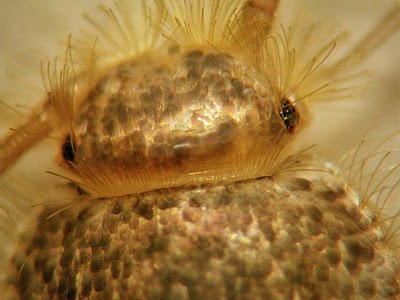
Thermobia domestica - The Firebrat
Thermobia domestica is an
insect discovered by American
entomologist and paleontologist Alpheus Spring Packard
in 1873. (Integrated Taxonomic Information System
2012) Thermobia (Greek root
"thermos" meaning hot) is
found primarily in
homes (domestica, root word from Latin
"domus" meaning house) as a pest. Historically,
this heat-seeking critter was found around bakery ovens
and fire stoves seeking starchy foodstuffs, which is
where it earned the nickname "firebrat."
(Adams 1933)
It's appearance is small, usually not reaching more than
half an inch (~12mm) in
length,
 but its impact can be large. With a flat, elongated
body and quick, agile movement, the Firebrat can occupy very small
spaces and be difficult to catch. These characteristics, coupled
with its love for carbohydrates, mean it can get into book bindings
and pry under wall paper to
eat the
starchy contents and cause a good deal of damage.
(Davies 1988)
but its impact can be large. With a flat, elongated
body and quick, agile movement, the Firebrat can occupy very small
spaces and be difficult to catch. These characteristics, coupled
with its love for carbohydrates, mean it can get into book bindings
and pry under wall paper to
eat the
starchy contents and cause a good deal of damage.
(Davies 1988)
This wingless wonder is often confused with its close
cousin the Silverfish, also from
Order Thysanura,
and is also prone to cause damage and vexation in the
home. Both species are considered "bristletails"
(Greek "thysanos" meaning "tassel" and "oura" meaning
"tail") and can be recognized by the plethora of
hair-like bristles that cover their bodies. (Hickman
et al. 2009) Both
are primitive insects with scaled exoskeletons that avoid
disturbances by being active at night, but there are
differences between the two. Firebrats are usually brown in
color with dark splotchy patterns, while Silverfish are
uniformly gray or silver with more of a sheen on their
bodies. Silverfish prefer moderate temperatures
with high humidity and Firebrats like high temperatures
with moderate humidity. (Housman 2007) This could be an
adaptation to avoid competition for a niche
indoors or out.
Thermobia domestica is a curious creature with
some interesting physical and behavioral
characteristics. It has the ability to not only
move very quickly, but also in a lateral or sideways
direction. Firebrats are covered in iridescent
scales which closely resemble those of a butterfly, and
their antennae are longer than their bodies. (Sweetman
1938) These
guys come from an ancient lineage of the first insects
virtually unchanged; they do not have wings because they
were around before other insects adaptively developed
them! One of the oldest known insect fossils is a Thysanuran from the Triassic period (250-200 million
years ago) found in the Ural Mountains. (Lanham
1964) Perhaps
what is most interesting about Thermobia is the
fact that they perform a complex
mating dance!
The following video shows footage of the Firebrat's movements as well as great close-up images of its physical characteristics.
To refer back to MultipleOrganisms.net click here.